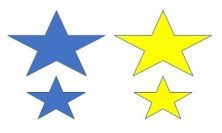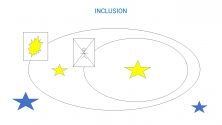In today’s post, we’re going to learn set theory using some simple manipulative games.
Smartick provides exercises to practice set theory through virtual manipulation. If you want to keep practicing with materials you can find at home, these games will help you learn more about set theory in a fun and experimental way.
Remember that a set is a collection of objects, which we call elements, that share a common feature. If you want to learn more about them, you can read this post, which explains sets simply using visual aids.
Constructing a logically structured material
The first thing you’ll need to do is to construct the logical material to represent the elements. So, what exactly is that? It’s just the material formed by pieces defined by concrete qualities. An example will help you understand.
The best-known logically structured materials are the Dienes blocks, but you can also use something as simple as stickers in these shapes:

You can download and print this pdf to use in various set games.
Making identification tags
Now let’s make the tags to identify the pieces of your material. In the case of the stars, they are defined by two qualities:
- Size: large and small.
- Color: blue and yellow.
Now you can identify them with labels like these:

You can download the tags here.
You can also find plenty of original ideas for making a logically structured material on the internet.
Making the set theory games
With the pieces and tags you’ve created, you can now play the following set games:
- Intersection
- Union
- Inclusion
Let’s find out how to play each one. We’ll use Venn diagrams as boards for our games, by changing their shape a bit. You can download the templates here:
Intersection and Union
To play these two games, first, use two tags to identify each of the sets.
In our example, we used a tag to indicate blue on the left, and a tag to indicate small on the right. Therefore, the area on the left will be filled with blue stars, and the area on the right will be filled with small stars. Now you just have to put the stars in the right place, according to the tags.
- The Intersection set will be the one that contains the blue and small stars (Just 1 element: the small blue star).
- The Union set will be the one that contains the blue or small stars (3 elements: the small blue and yellow stars, and the big yellow star).

Take note that 1 star has been left out (the big yellow star) because it doesn’t meet the conditions indicated by the tags.
Inclusion
To play this game, first place 2 tags to identify each of the sets, just as before.
In the image below, we used a tag to indicate yellow on the containing set, and a tag to indicate “not small” (so, big) on the subset. Therefore, the containing set will be made up of yellow stars, and the subset will contain big yellow stars. Like before, you just have to place the stars in the correct place according to the tags.

It’s important to be aware that only the big yellow star is in the subset because it meets the criteria of both tags. The other yellow star cannot be placed in the subset, because the tag tells us whatever is in the subset can’t be small.
See how easy it is to understand the set logic with such simple manipulative games? Once you’ve done this you can create more sophisticated materials with more characteristics. Make it more difficult until you become an expert!
If you liked this post, you can share it with others so they can use these simple games to learn about sets.
If you want to keep practicing with virtual exercises and manipulative games involving sets, register with Smartick and try it for free.
Learn More:
- Introduction to Sets and Subsets
- How to Group Sets and Create Venn Diagrams
- Working with Venn Diagrams in Smartick
- Venn Diagrams, Set Diagrams and Logic Diagrams
- Learn about Set Theory and Study Techniques







